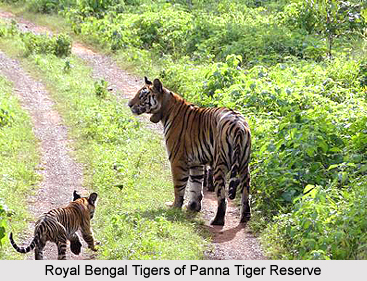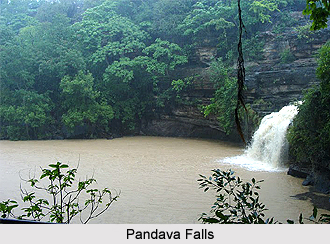 Tourism of Panna district offers a number of options including several temples, waterfalls and the most famous Panna National Park. The district of Panna is the most revered pilgrimage for the followers of the Pranami sect world over. With a sanctuary for rare wild life and fauna and a diamond mine, this district has transformed its royal past into a vibrant and lively present. Roll-on meadows dotted with evergreen trees, hills and forests and the famous temples strike a very fine blend of Muslim and Hindu architecture.
Tourism of Panna district offers a number of options including several temples, waterfalls and the most famous Panna National Park. The district of Panna is the most revered pilgrimage for the followers of the Pranami sect world over. With a sanctuary for rare wild life and fauna and a diamond mine, this district has transformed its royal past into a vibrant and lively present. Roll-on meadows dotted with evergreen trees, hills and forests and the famous temples strike a very fine blend of Muslim and Hindu architecture.
Pilgrimage Tourism in Panna District
There are many temples of Panna District. The Mahamati Prannathji Temple in Panna district is the most important temple of Pranamies. This temple reflects their social and religious life. It attracts number of devotees during Sharada Purnima. It is believed that Mahamati Prannathji lived at the site for eleven years. After that, he attained "Samadhi" inside one of the domes of this temple. The temple was built in 1692 and has Muslim and Hindu architectural styles in its domes and lotus formations. The temple is divided into six parts namely Shri Gummatji, Shri Bangalaji, Shri Sadguru Mandir, Shri Baijurajji Mandir, Shri Chopada Mandir and Shri Khijada Mandir. The prime attraction of this pilgrimage site is Shri Gummatji Temple. It is a circular building with nine marble domes. There are eight of these domes representing the eight directions and central dome has a divine golden "Kalasha". There is also a great temple gate called Kaman Darwaza, which is constructed by using silver metal.
Padmavati Devi or Badi Devi temple is another temple of great importance, which is located on the north-west corner near Kilkila River. It is believed to be a very old temple. It has also the great religious and historical importance. Another temple is the Baldeoji Temple, which is in the Palladian style as a scaled down replica of St. Paul`s Cathedral in London under the supervision of Mr. Manly, an Italian expert. The Jugal Kishoreji temple is the most prominent Hindu temple in Panna district. It was constructed in Bundela temple style. Nat Mandapa, Bhog Mandapa, Garbh Griha and Pradkshana path are present in this temple. Some of the other temples of importance in this district are Lord Ram-Janki temple, Sarang temple, Swamiji temple, Baiji temple, Govindji temple, etc. The dominant architectural plan of most of the temples is uniformly homogenous. After the declination of rule of Mughal Dynasty in India, Muslim architectural wisdom appears in these temples.
 Nature Tourism in Panna District
Nature Tourism in Panna District
The district of Panna is rich in waterfalls and scenic views. Panna is located on the Vindhyachal Ranges, which give Panna several beautiful sites. The beautiful waterfalls like the Pandava Fall, Brihaspati Kund, Nachne, Nand-Chand, etc. are some of the attractions in this district. The Pandav Fall is about 12 kilometers from Panna towards Khajuraho. This fall is situated inside the Panna National Park but very close to the national highway. It is a perennial fall, which is fed by local springs. Lush green surrounding makes the fall spectacular. At the foot of this fall there are some ancient caves overlooking a large pool of water. About 100 feet high, the fall has a beautiful picnic spot. Another fall in Panna is the Gatha fall. It is located on the other side of the highway. About 300 feet high, this fall is very impressive and presents a very pleasant sight from the road itself.
Leisure Tourism in Panna District
Panna Tiger Reserve is the twenty-second Tiger Reserve of India and fifth in the Madhya Pradesh state. It is located in the Vindhya Mountain Range and spreads over the Panna district and Chhatarpur district in the north of the state. The Ken River, which flows through this Reserve, is a home for maggar, gharial and other aquatic fauna. The Reserve is open for visitors for eight months in a year, i.e., from the month of November to June. Indian Teak (Tectona Grandis), Madhuca, Diospyros melanoxylon, Buchanania lanzan, Anogeissus latifolia, Lannea coromandalica, A. pendula, Boswellia, Acacia catechu, Aegle marmelos, Zizyphus spp., Butea, Sterculia urens, Gardenia spp., Dendrocalamus strictus, common bamboo, etc. are the major flora of this area. The animals like Royal Bengal Tiger, Leopard, Wolf, Wild Dog, Sloth Bear, Wild Boar, Samber, Chital, Hyena, Nilgai, Chausingha, Chinkara, Porcupine, Rusty Spotted Cat, Jungle Cat, Hare, Rattle, Gerbil, Tree Shrew, etc, are seen in the National Park. About 200 species of birds have been identified which include host of winter migratory birds. Aquatic Animals including crocodiles are found in the Ken River besides host of fish species, turtles and others.






